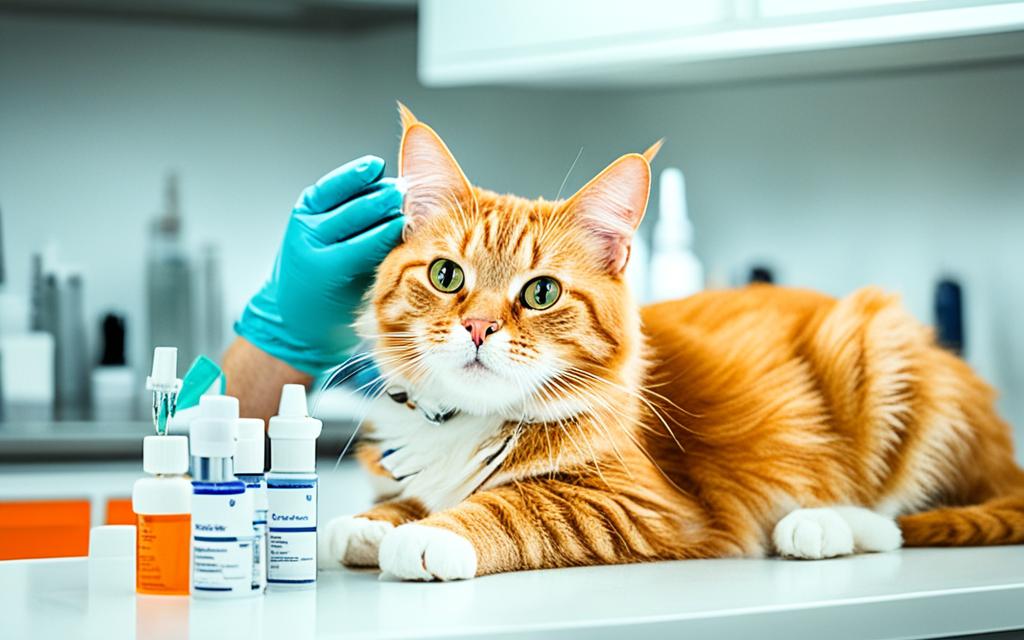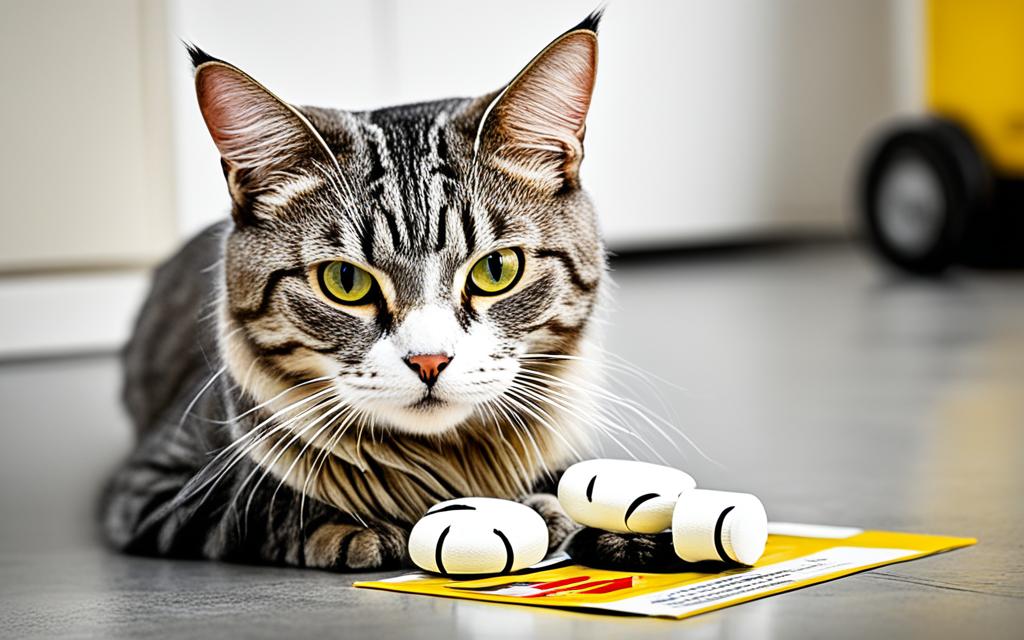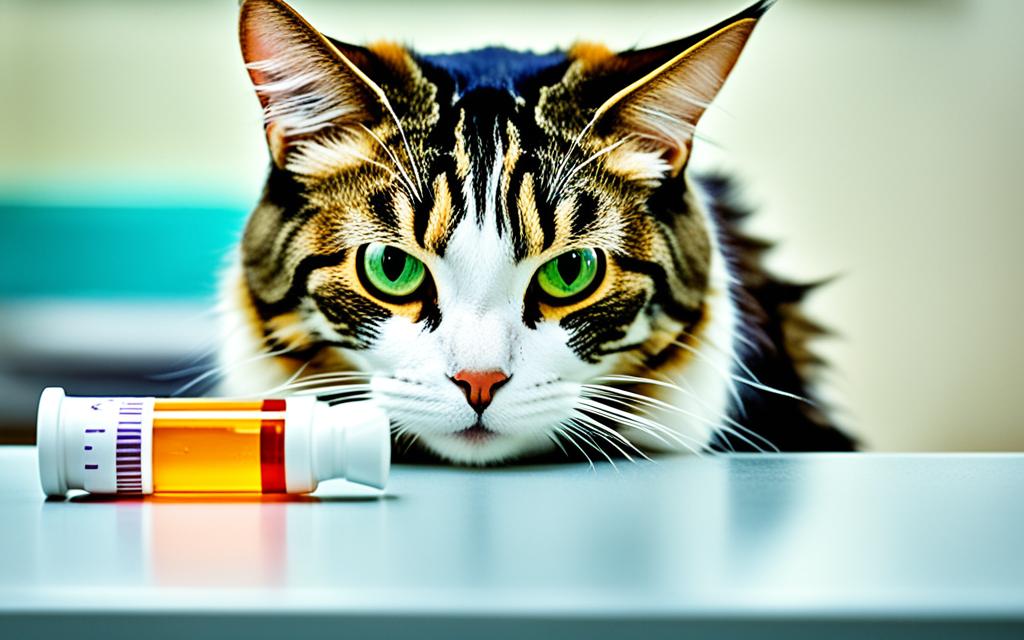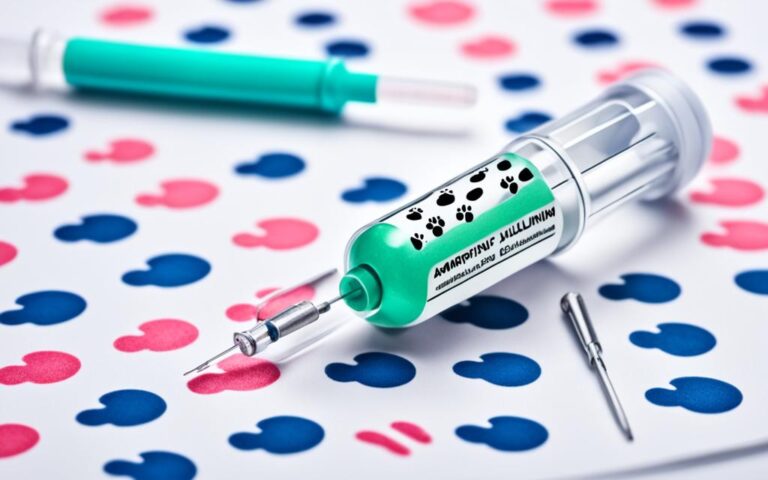Understanding Tramadol for cats: Uses, Risks, and Advice
Did you know tramadol is sometimes given to cats for pain even though it’s not officially approved for them1? This is common in veterinary medicine. Tramadol helps manage pain in cats, especially for conditions like osteoarthritis. It blocks pain signals by attaching to nerve cell receptors1.
Yet, tramadol’s use in cats needs careful thought and watching. Vets balance its benefits with possible side effects and drug interactions. We will look at using tramadol for cat pain, how it’s given, side effects, and how to use it safely.
Key Takeaways
- Tramadol is a synthetic opioid used off-label to treat pain in cats, with a range of potential side effects.
- Tramadol can take 1-2 hours to take effect and may require weeks for full pain relief, especially in pets with chronic conditions.
- Side effects in cats can include vomiting, constipation, sedation, dilated pupils, and behavioral changes.
- Tramadol should be used cautiously in cats with certain medical conditions and may interact with other medications.
- Overdose of tramadol can lead to serious symptoms, so proper dosing and veterinary guidance is essential.
Table of Contents
What is Tramadol?
Definition and Brand Names
Tramadol is a synthetic opioid used for pain relief in dogs and cats2. It’s listed as a Schedule IV controlled drug2. For humans, it comes in different brand names like ConZip® and Qdolo® and as a generic drug2. But, it’s not for veterinary use approved by the FDA2. Still, vets might use it legally for pets, known as “off-label” or “extra-label” use.
Off-Label Use in Veterinary Medicine
It’s often given to cats for pain, even without the FDA’s nod, for issues like osteoarthritis2. Sometimes, it’s mixed into a special medication just for that pet2. This use is generally safe but might lead to pets feeling too sleepy, anxious, eating less, or throwing up or having diarrhea2.
Too much tramadol is bad and could mean a trip to the vet right away2.
| Tramadol Brand Names | Description |
|---|---|
| Ultram, ConZip, Durela, Ralivia, Rybix, Ryzolt, Tridural, Zytram | Tramadol comes in many names for people but not for pets from the FDA. Yet, vets can prescribe it to animals for pain off-label. |
“Tramadol is gaining acceptance in veterinary medicine to treat mild to moderate pain in dogs and cats.”3
How is Tramadol Administered to Cats?
Tramadol, a synthetic opioid, helps manage chronic pain in cats. It comes in different forms, making it easy to give based on the cat’s needs and what they like. This flexibility is a big plus for treating our furry friends4.
Oral Administration
Using the mouth is the main way to give cats tramadol. It can come as a tablet, capsule, liquid, or even a tasty treat. Since the tablets are not tasty, liquid or treats might be better for cats to eat or drink4.
Dosing with or without Food
Cats can take tramadol with or without food. Mixing it with their meal can hide the bad taste and stop vomiting in cats with delicate tummies4. The starting dose for cats is usually 2 mg per kilogram every 8 to 12 hours. But, the vet will decide the right dose for every cat4.
Always listen to your vet when giving tramadol. Proper and regular doses are key to helping your cat feel better. So, be careful to give it just as the doctor says5.

“The guidelines emphasize the importance of proactive and preemptive pain management over a reactive approach in both acute and chronic pain scenarios.”5
Potential Side Effects of Tramadol in Cats
Tramadol is mostly okay for cats, but it might make them feel a bit off6. Some cats might get sleepy or have big eyes. They could feel worried, make a lot of noise, or seem jumpy. Others might shake, eat less, throw up, get the runs, or be stopped up7. But, big problems like very deep sleep or trouble moving are rare. There’s also something called serotonin syndrome to watch out for.
After taking Tramadol, cats might feel pain less than dogs. This is because of how their bodies break it down and use it8. Tramadol is an affordable, easy to give medicine that could help with bone pain in cats7.
- Mild side effects of Tramadol in cats may include: sedation, dilated pupils, anxiety or vocalization, agitation, muscle tremors, decreased appetite, vomiting, diarrhea, and constipation6.
- Severe side effects of Tramadol in cats may include: excessive drowsiness, incoordination, and serotonin syndrome6.
If you see side effects in your cat, call the vet right away. It’s very important to give the right dose and keep an eye on your cat when they’re on Tramadol6.
“Tramadol has been used as an analgesic agent in surgical procedures for cats to manage postoperative pain.”8
Up to 61% of older cats might have osteoarthritis7. As cats get even older, this number might go up to 90%. Tramadol could be really helpful for these cats’ pain.
Remember, don’t give Tramadol to cats who have had seizures, problems with their metabolism, or if they’re taking certain drugs6. Always talk to your vet to make sure Tramadol is right for your cat.
Precautions and Risk Factors
Using Tramadol in cats has risks and precautions everyone involved should know. It’s not safe for cats that react badly to opioid drugs9. Be careful giving Tramadol to cats with past seizures, or who have major liver or kidney problems. The same goes for older or weak cats9.
Hypersensitivity and Contraindications
Don’t give Tramadol to cats known to be sensitive to it or other opioid drugs. Doing so might cause a dangerous reaction10. Always talk to the vet about any drug allergies before starting Tramadol.
Cautions for Specific Medical Conditions
Treat Tramadol with care for cats with certain health issues. Cats with a seizure history might face a higher seizure risk with Tramadol9. Also, cats with bad liver or kidney function might not handle Tramadol well. This could lead to harmful outcomes9. Older or frail cats might react stronger to Tramadol, needing lower doses or more attention9.
Use Tramadol cautiously in pregnant or nursing cats. Its use should only happen if it’s clearly beneficial, as decided by the vet9. Some health problems, like severe asthma or if a cat can’t pass food through the gut, mean Tramadol can’t be used. In these cases, find other ways to manage pain9.

Always share your cat’s full health history and any current issues with the vet. This helps make sure Tramadol is used safely and well for your cat10119. Think carefully about the benefits and risks of this medicine before deciding to use it.
Drug Interactions with Tramadol
Tramadol is a powerful pain reliever that mixes with many drugs12. If your cat is taking supplements or other medicines, make sure your vet knows. Mixing these can cause more side effects or stop the medicine from working12.
SAMe, antifungals, and some antidepressants affect tramadol12. Be careful; they can lead to more side effects like breathing problems, seizures, or serious serotonin syndrome symptoms12.
Tramadol can also change how certain blood pressure drugs work12. This might cause very low blood pressure, especially in people with existing blood pressure issues or who take specific drugs12.
It could cause heart rhythm problems by affecting the QTc interval12. But, usually, the risk isn’t high12.
Before your pet starts taking tramadol, talk with your vet about all their current medications and supplements12. Doing this and keeping a close eye on possible drug interactions can make tramadol safer and more effective for managing your cat’s pain12.
Know that some anti-fungal medications might make tramadol’s levels rise in the body, upping side effects13. Also, mixing it with certain antidepressants could stress the body and lead to serotonin syndrome13.
Mixing tramadol with other pain relievers could be risky, especially for breathing problems13. It’s important for the vet to watch the dosage and effects carefully when tramadol is used with other CNS or respiratory drugs13.
| Medication Class | Potential Interactions with Tramadol |
|---|---|
| Antifungals | Ketoconazole, Itraconazole |
| Antidepressants | Selective Serotonin Reuptake Inhibitors (SSRIs), Tricyclic Antidepressants |
| Opioid Medications | Other opioid pain relievers |
| Supplements | SAMe |
| Antiemetics | Metoclopramide, Ondansetron |
| Antihypertensives | Medications that can affect blood pressure |
It’s very important to tell your vet about all your cat’s medicines and supplements before tramadol12. By being careful with tramadol and watching for interactions, you make it safer for your cat12.
Monitoring and Storage Guidelines
When giving tramadol to cats, there’s no need for constant watching by the pet owner4. Still, vets might suggest regular check-ups, like blood tests, especially if your cat’s health is complex or when taking other drugs4.
To keep tramadol working safely, how you store it matters a lot. The tablets and capsules like to be at a comfy room temperature, about 25°C (77°F), in a dry, dark spot4. If it’s in a liquid form, then keeping it cool in the fridge might be needed. Always check the label for the right storage tips4.
Remember, tramadol is a special kind of medicine that needs extra care. It should be kept in a locked place to stop any wrong use or accidents by pets or people at home4.
| Storage Requirement | Recommendation |
|---|---|
| Tramadol Tablets/Capsules | Store at room temperature (around 25°C or 77°F), away from moisture and light |
| Tramadol Liquid Formulations | Follow storage instructions on the product label, which may include refrigeration |
| Controlled Substance Status | Store in a locked cabinet or safe with limited access |
Obeying these storage rules and being cautious keeps your cat safe when using tramadol.
Tramadol for cats: Dosage and Administration
Tramadol is often used to control pain in cats. Vets usually start with a 2 mg dose per kilogram of the cat’s weight. This is given every 8 to 12 hours. But, the exact amount should be decided by the vet. They consider the cat’s weight, health issues, the pain type, and other drugs the cat might be on.
Dosage Guidelines
For chronic pain from osteoarthritis, cats might get 1-4 mg of tramadol per kilogram twice a day. Sometimes, cats become sleepy or restless while on tramadol. Clinical trials show that it works well for pain. Cats feel better and move more within 1 to 2 hours of taking it for sudden pain.
Missed Dose Instructions
If a tramadol dose is missed, owners should give it when they remember. But, if it’s near the time for the next dose, they should skip the one they missed. They should then just give the next dose as usual. Not giving double doses is important.
Tramadol for cats can mix badly with some drugs like certain painkillers and antidepressants. Some cats might have allergic reactions to tramadol, showing seizures or being very sleepy or restless. Those with special health conditions or who are having babies should take tramadol carefully. Don’t give tramadol with acetaminophen to cats because it’s harmful to them.
| Dosage for Cats | Dosage for Dogs |
|---|---|
| 0.5 to 1 mg per pound (1 to 2 mg/kg) every 12 to 24 hours14 | 1 to 2 mg per pound (2 to 4 mg/kg) every 8 to 12 hours14 |
| Oral bioavailability of approximately 60%, with peak concentration reached in 45 minutes15 | 99% of tramadol is metabolized in dogs15 |
| Suggested dose for chronic pain: 5 to 10 mg/kg every 8 to 12 hours15 | Dose range: 2 to 5 mg per pound (4 to 10 mg/kg) orally every 8 hours14 |
Tramadol can help cats manage pain. Always stick to what the vet recommends. Watch out for side effects and bad drug mixes. Using tramadol safely means following the vet’s plan closely.
Emergency Situations and Overdose
Cats overdosing on tramadol face a serious risk. They might need urgent care from a vet16. Symptoms of an overdose include extreme sleepiness, throwing up, and a lack of balance. They could also be very talkative, upset, and shake a lot, have big eyes, and drool too much16. If a cat eats tramadol with acetaminophen, it’s especially dangerous. In this case, a vet’s help is absolutely necessary right away16.
If you think your cat has had too much tramadol, call your vet or a poison control center16. Overall, tramadol is safer than some other pain meds for pets. But, care is needed when giving it to avoid bad side effects. This is true even at normal doses, because sometimes cats or dogs can get serotonin sickness16.
If a cat or dog gets too much tramadol, there’s usually a good chance they’ll get better. They need to stop taking the drug, get fluids, and have some other meds to help them feel better. For some, even though tramadol stays in their bodies longer, it’s not usually a big worry17.
Cats turn tramadol into a pain-fighting substance differently than dogs do. This makes tramadol work better for pain in cats. But exact doses can vary for each animal17. Dogs make a different substance from tramadol. This makes us wonder how well tramadol works for dog pain compared to cat pain17.
As a pain medicine, tramadol is watched closely. Vets need special permission to give it out. It’s closely managed because it’s addictive. Tramadol can cause stomach problems and change how pets act. It can also be dangerous if too much is taken17.
Tramadol works well with some pain meds. But it doesn’t go well with certain others, like a type of depression drug. Mixing tramadol with bad pairings can make pets or people very sick17.
The FDA looks after controlled drugs, while the DEA makes sure the rules are followed. If a vet loses any controlled drugs, they need to tell the police and the DEA. Butorphanol and buprenorphine are the only opioids that can be given to animals18.
The FDA has special plans to make sure opioids are used safely. These plans help prevent the wrong use of these strong painkillers18. There are other ways to help pets with pain without using opioids. These are safe and effective pain treatments for pets18. The AVMA can teach vets about the signs of drug abuse. This helps them spot if someone might be using or selling these drugs in the wrong way18.
Clients who ask for certain drugs a lot might be misusing them. Vets or their staff who suddenly don’t seem okay might be using drugs in a bad way. Signs like mood swings or not wanting to be around other people could mean they are struggling18.
Vets should tell pet owners how to keep opioid drugs safe. They should also let them know how to get rid of the drugs safely if they don’t need them anymore. If a dog eats too much of an opioid, vets can get emergency advice from special phone services. The FDA and vets are working hard to stop drug problems before they start18.
Benefits and Efficacy of Tramadol for Pain Relief in Cats
Tramadol is often given to cats for pain, helping with sudden (acute) or long-lasting (chronic) pain. It acts by attaching to pain spots in the body, stopping pain signals to the brain19. It also boosts certain messengers in the body that help dull the feeling of pain19.
After surgeries like spaying, neutering, or dental work, studies show that tramadol helps cats feel better19. It’s also been found to help cats with arthritis move more and feel less pain19. This shows tramadol might work for everyday aches and pains in cats too.
Mechanism of Action
Tramadol works by locking onto tiny pain centers in the body, decreasing pain feelings19. It also boosts certain messengers that help lessen pain19. This dual help is why tramadol is good at making cats feel less pain.
Studies suggest that tramadol does well because it not only blocks pain signals but also works a bit like antidepressants20. Its unique mix of effects is what makes it a strong choice for cat pain20.
But, before giving your cat tramadol, talking with a vet is a must. They’ll figure out the right dose and watch for side effects20. Vets look at the cat’s full health history to make sure tramadol is a safe and good option for them.
Tramadol is proven to be good for many cat pain cases. Its special way of working on the body’s pain network and mood messengers helps a lot. Yet, always work with a vet to use this drug the right way192120.
Conclusion
Tramadol is a synthetic opioid often used off-label to manage pain in cats22. It’s important to note that more research is needed to understand its purely pain-reducing effects in felines22. But, it has been successful in lowering the amount of anesthesia needed during surgery22. This makes it very useful in veterinary settings23. As always, the right way to give tramadol, the correct amount, and checking its effect involves close work between pet owners and their vets24.
Knowing about possible side effects and precautions in tramadol’s use in cats is crucial24. Remember, tailoring the treatment based on your cat’s health history and other medications is key23. Following your vet’s advice on how to use and give tramadol will help ensure your cat’s well-being while still easing their pain24.
So, Tramadol for cats can be a game-changer in easing both short and long-term pain when managed wisely by a vet23. Nonetheless, owners must stay alert to the Tramadol risks, working closely with their vet to dodge any dangers24.
FAQ
What is Tramadol and how is it used in veterinary medicine?
How is Tramadol administered to cats?
What are the potential side effects of Tramadol in cats?
What precautions and risk factors should be considered when using Tramadol in cats?
Can Tramadol interact with other medications?
How should Tramadol be stored and monitored?
What is the proper dosage of Tramadol for cats?
What should I do if I suspect a Tramadol overdose in my cat?
How does Tramadol work to provide pain relief in cats?
Source Links
- Tramadol | VCA Animal Hospitals
- Tramadol for Dogs and Cats
- Uses, Dosage & Side Effects
- Management of Chronic Pain in Cats
- 2022 AAHA Pain Management Guidelines for Dogs and Cats
- Side Effects of Tramadol for Cats | Canna-Pet®
- Analgesic efficacy of tramadol in cats with naturally occurring osteoarthritis
- Clinical pharmacology of tramadol and tapentadol, and their therapeutic efficacy in different models of acute and chronic pain in dogs and cats
- Butorphanol | VCA Animal Hospitals
- 2022 AAHA Pain Management Guidelines for Dogs and Cats
- Pain Treatment
- Tramadol: Uses, Interactions, Mechanism of Action
- Tramadol in Veterinary Medicine – Facts and Information | PetCoach
- Tramadol Hydrochloride (Ultram®) for Dogs and Cats
- Tramadol for Dogs & Cats: Uses, Dosage, & Side Effects | [site:name]
- Tramadol Overdose
- Mar Vista Animal Medical Center
- The Opioid Epidemic: What Veterinarians Need to Know
- Is tramadol an effective analgesic for dogs and cats?
- Tramadol For Cats: Pain Relief And Management | CareCard
- Tramadol: Limited Benefit for OA Pain
- No title found
- Injectable and Oral Tramadol for Pain Control – WSAVA 2018 Congress
- Tutorial on Finding a Reliable Tramadol Pet Pharmacy – Southern Harvest Insurance







